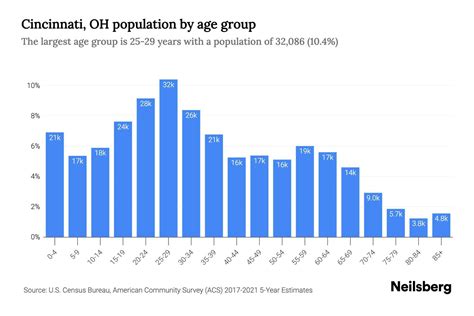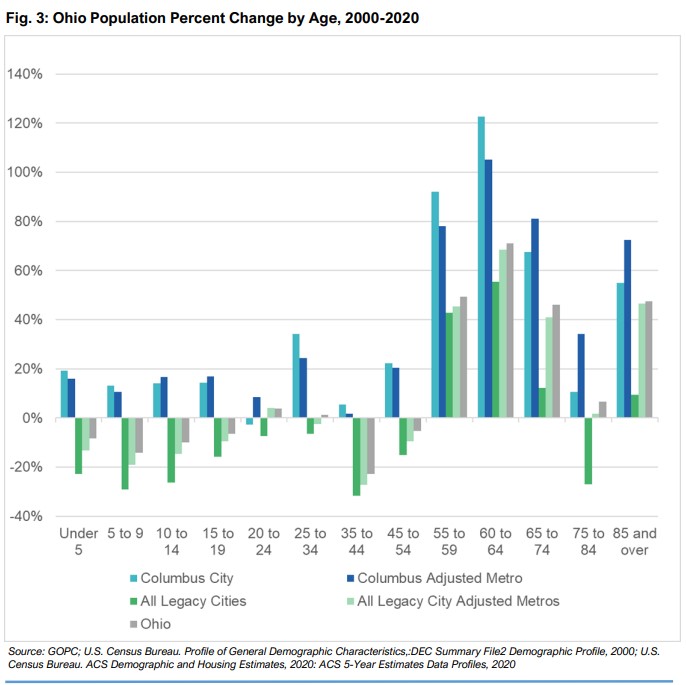Cincinnati Ohio Population

Cincinnati, Ohio, a city situated in the southwestern part of the state, has a rich history and a diverse population. As of the 2020 United States Census, the city's population stands at approximately 309,317 people. This number represents a slight increase from the 2010 census, which reported a population of 296,943. The Cincinnati metropolitan area, which includes several surrounding counties in Ohio, Kentucky, and Indiana, has a significantly larger population, with over 2.1 million residents, making it the 28th largest metropolitan area in the United States.
The demographic makeup of Cincinnati is characterized by a mix of racial and ethnic groups. According to the American Community Survey (ACS) 2019 estimates, the city's population is roughly 49.3% White, 45.9% Black or African American, 3.4% Asian, and 2.8% Hispanic or Latino. These demographics play a significant role in shaping the city's cultural landscape, with various festivals and events celebrating the diversity of its inhabitants. For instance, the Cincinnati Music Festival, which highlights African American music, and the Oktoberfest Zinzinnati, celebrating German heritage, are just a couple of examples of the city's vibrant cultural scene.
Key Points
- The population of Cincinnati, Ohio, as of 2020, is approximately 309,317.
- The city's population has seen a slight increase since the 2010 census.
- Cincinnati has a diverse population with significant racial and ethnic groups.
- The metropolitan area of Cincinnati is one of the largest in the United States, with over 2.1 million residents.
- The city's cultural events reflect its demographic diversity, including festivals celebrating different ethnic and musical heritages.
Historical Population Trends

Cincinnati’s population has experienced fluctuations over the years, influenced by various factors such as economic conditions, urban renewal efforts, and suburbanization. In the early 20th century, Cincinnati was one of the fastest-growing cities in the United States, with its population peaking in the 1950s. However, like many other American cities, Cincinnati faced significant challenges in the latter half of the 20th century, including population decline and economic stagnation, largely due to suburbanization and the decline of the manufacturing sector.
Despite these challenges, Cincinnati has been engaged in revitalization efforts aimed at reinvigorating its urban core and attracting new residents. These efforts include the redevelopment of the riverfront area, investments in education and healthcare, and initiatives to foster a more diverse and inclusive community. As a result, the city has seen a resurgence in popularity, particularly among young professionals and families, drawn by its cultural attractions, educational institutions, and a growing tech industry.
Economic and Educational Landscape
Cincinnati boasts a strong and diverse economy, with major industries in healthcare, education, technology, and manufacturing. The city is home to several Fortune 500 companies, including Procter & Gamble, Kroger, and Macy’s. Additionally, Cincinnati has a thriving startup scene, with various incubators and accelerators supporting innovation and entrepreneurship. The city’s educational landscape is equally impressive, with the University of Cincinnati and Xavier University being two of the prominent institutions, offering a range of academic programs and contributing to the city’s intellectual and cultural vitality.
| Demographic Category | Percentage of Population |
|---|---|
| White | 49.3% |
| Black or African American | 45.9% |
| Asian | 3.4% |
| Hispanic or Latino | 2.8% |

Future Outlook and Challenges

Looking ahead, Cincinnati faces both opportunities and challenges. The city’s efforts to reinvent itself as a hub for innovation and entrepreneurship are promising, but it must also address issues such as racial disparities, economic inequality, and the need for sustainable urban development. By leveraging its strengths in education, healthcare, and technology, while addressing its social and economic challenges, Cincinnati can continue to evolve as a vibrant and inclusive city, appealing to a wide range of individuals and businesses.
Furthermore, the city's strategic location, at the confluence of the Ohio River and the Licking River, offers potential for waterfront development and enhancement of its natural beauty. Investments in green spaces, public transportation, and community facilities can further enhance the quality of life for its residents, making Cincinnati an attractive option for those looking to relocate or start a new venture.
What is the current population of Cincinnati, Ohio?
+As of the 2020 United States Census, the population of Cincinnati, Ohio, is approximately 309,317.
What are the major industries in Cincinnati?
+Cincinnati's economy is diverse, with major industries in healthcare, education, technology, and manufacturing. The city is also home to several Fortune 500 companies.
What efforts is Cincinnati making to revitalize its urban core?
+Cincinnati has been engaged in various revitalization efforts, including the redevelopment of the riverfront area, investments in education and healthcare, and initiatives to foster diversity and inclusivity.
In conclusion, Cincinnati, Ohio, presents a complex and dynamic picture, with its diverse population, rich cultural heritage, and efforts towards urban renewal. As the city continues to evolve, addressing its challenges while leveraging its strengths, it is poised to become an even more attractive and vibrant place to live, work, and visit. With its strong foundation in education, healthcare, and technology, and its commitment to inclusivity and sustainability, Cincinnati’s future looks promising, offering a high quality of life for its residents and a unique blend of Midwestern charm and urban sophistication.



